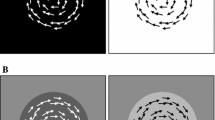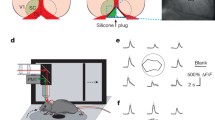Summary
Recordings were made in the brain of Sphinx ligustri of pairs of directionally selective movement detectors, and the spike trains analysed with a computer for possible synaptic connections between two classes of movement detector. (1) Neurones with large binocular fields which arise in the medial protocerebrum and project to the medulla or lobula of one optic lobe, or to the ventral nerve cord. (2) Movement detectors which project from the lobula complex of one optic lobe to the opposite medial protocerebrum. The majority of the second group had back-to-front preferred directions over the ipsilateral eye, and of these many were weakly sensitive to stimuli to the opposite eye. The ipsilateral receptive field covered most of the eye.
Optic lobe output cells with the appropriate preferred direction provide a powerful excitatory input to the binocular movement detectors centrifugal to the medulla. Each centrifugal movement detector probably receives excitatory inputs from no more than two optic lobe output cells with back-to-front preferred direction. The same set of optic lobe output neurones probably feeds several cells projecting to the medulla and lobula of both optic lobes, and, possibly, to the ventral nerve cord.
Evidence was obtained that the optic lobe output cells themselves receive few excitatory inputs, and that therefore the receptive fields of their input cells are large.
Two moving stimuli were presented in different areas of the receptive field. Movement through the null direction in one area inhibited the response to movement in the preferred direction in another area. This suppression was stronger in optic lobe output cells with front-to-back preferred direction than in units with back-to-front preferred direction. Thus the optic lobe output cells, or wide-field units feeding them, receive inhibitory inputs from wide-field units with the opposite preferred direction.
Similar tests in which moving stimuli were presented to both eyes gave results indicating that the binocular centrifugal movement detectors may receive inhibitory inputs from movement detectors with back-to-front preferred direction. The possible functional significance of these inhibitory inputs is discussed.
Similar content being viewed by others
References
Bishop, L. G., Keehn, D. G., McCann, G. D.: Motion detection by interneurons of optic lobes and brain of the flies, Calliphora phaenicia and Musca domestica. J. Neurophysiol. 31, 509–525 (1968).
Blest, A. D.: Some modifications of Holmes's silver method for insect central nervous systems. Quart. J. micr. Sci. 102, 413–417 (1961).
Collett, T.: Centripetal and centrifugal visual cells in medulla of the insect optic lobe. J. Neurophysiol. 33, 239–256 (1970).
Collett, T. S., Blest, A. D.: Binocular, directionally selective neurones, possibly involved in the optomotor response of insects. Nature (Lond.) 212, 1330–1333 (1966).
Freeman, J. A.: The cerebellum as a timing device: an experimental study in the frog. In: Neurobiology of cerebellar evolution and development (R. Llinas, ed.), p. 397–420. Chicago: Am. Med. Assn. Educ. and Res. F. 1969.
Grüsser, O. J., Grüsser-Cornehls, U.: Neurophysiologie des Bewegungssehens. Ergebn. Physiol. 61, 178–265 (1969).
Kandel, E. R., Frazier, W. T., Coggeshall, R. E.: Opposite synaptic actions mediated by different branches of an identified interneuron in Aplysia californica. Science 155, 346–349 (1967).
Land, M. F.: Orientation by jumping spiders in the absence of visual feedback. J. exp. Biol. 54, 119–140 (1971).
Levick, W. R., Oyster, C. W., Takahashi, E.: Rabbit lateral geniculate nucleus: sharpener of directional information. Science 165, 712–714 (1969).
McCann, G. D., Dill, J. C.: Fundamental properties of intensity, form and motion perception in the visual nervous system of Calliphora phaenicia and Musca domestica, J. gen. Physiol. 53, 385–413 (1969).
Moore, G. P., Perkel, D. H., Segundo, J. P.: Statistical analysis and functional interpretation of neuronal spike data. Ann. Rev. Physiol. 28, 493–522 (1966).
—, Segundo, J. P., Perkel, D. H., Levitan, H.: Statistical signs of synaptic interaction in neurons. Biophys. J. 10, 876–900 (1970).
Perkel, D. H., Gerstein, G. L., Moore, G. P.: Neuronal spike trains and stochastic point processes. 11. Simultaneous spike trains. Biophys. J. 7, 419–440 (1967).
Segundo, J. P., Perkel, D. H., Wyman, H., Hegstadt, H., Moore, G. P.: Input-output relations in computer simulated nerve cells. Influence of the statistical properties, strength, number and inter-dependence of excitatory pre-synaptic terminals. Kybernetik 4, 157–171 (1968).
Strausfeld, N. J., Blest, A. D.: Golgi studies on insects. 1. The optic lobes of Lepidoptera. Phil. Trans. B 258, 81–134 (1970).
Waldron, I., Wilson, D. M.: Latency relationships between loosely coordinated locust flight motor neurons. J. exp. Zool. 170, 293–300 (1969).
Wilson, D. M.: Central nervous mechanisms for the generation of rhythmic behaviour in arthropods. Symp. Soc. exp. Biol. 20, 199–228 (1966).
Wyman, R. J.: Multistable firing patterns among several neurons. J. Neurophysiol. 29, 807–833 (1966).
—: Lateral inhibition in a motor output system. 1. Reciprocal inhibition in dipteran flight motor system. J. Neurophysiol. 32, 297–306 (1969).
Author information
Authors and Affiliations
Additional information
I am very greatful to F. A. Miles for helpful discussion and criticism. Financial support came from the U. K. Science Research Council.
Rights and permissions
About this article
Cite this article
Collett, T. Connections between wide-field monocular and binocular movement detectors in the brain of a hawk moth. Z. vergl. Physiologie 75, 1–31 (1971). https://doi.org/10.1007/BF00335135
Received:
Issue Date:
DOI: https://doi.org/10.1007/BF00335135




